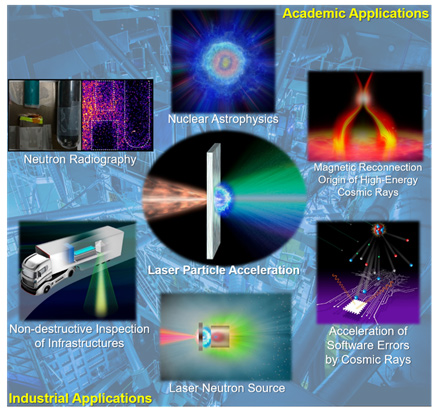Nuclear Photonics (NP)
Summary
Nuclear Photonics is the new field of science born in 2010. The NP group at ILE established in April 2018 to explore this new area by developing unprecedented academic research and industrial applications by inducing nuclear reactions using laser technology. In order to achieve this extreme condition, high power lasers are used to generate (high-energy X-ray / γ-ray) or secondary particles (ion/electron).
Therefore, the NP group is promoting a wide range of research areas from industry to academia such as astrophysics through our key technology: Nuclear Photonics.
Research Content
Laser-driven ion acceleration
The interaction of high power laser with a target at a thickness of 10s of nanometer to 100s of micrometer (about the cross-section of the hair) in an extremely short time scale (about 1 trillionth of a second) leads to the production of strong electromagnetic fields. This field can be used to accelerate ions at tens of MeV (million electron volts) in very short distances (tens of microns). Until now the ion acceleration has been done only using conventional acceleration method at significantly larger sizes, but now with the current trend in the development of high power lasers, this field of science is evolving.
The NP group at ILE explores different techniques and mechanisms to enhance the ion generation and acceleration via Target Normal Sheath Acceleration (TNSA) and Radiation Pressure acceleration (RPA). At TNSA, the interaction of lasers at intensities of (>1018 Wcm-2) creates hot electrons population with an energy of approximately similar to the ponderomotive force of the laser at its focus. As a result, the electrons propagate through the target into the vacuum and produce a sheath field at the rear side. As the target becomes positively charged (due to the escaping electrons), a sheath field is generated, which leads to the acceleration of ions. On the contrary to TNSA which acceleration occurs at the rear side, RPA works with intensities of (>1021 Wcm-2) when the whole plasma accelerates at whole by means of light pressure.
In addition to the mechanisms mentioned above which are currently in development, the NP group aims to explore a mechanism that gives hints to the cosmic phenomena.
Laser-driven neutron source
The generation of mult-MeV ion beam has produced a clear path towards the development of fusion neutron sources. The neutrons are produced from the interaction of ions (e.g. protons, deuterons) generated from the target (known as pitcher) with a converter (known as catcher). These neutrons are above 100s of KeV in temperature known as fast neutrons. They have a high penetration capability and ability to extract information from the medium they are travelling in. Here at ILE, the NP group develop neutron sources that can be used for different applications from non-destructive evaluation to imaging, healthcare and science. These sources are extremely short in time, about sub-picosecond (one billionth of a second) compared to millisecond sources in nuclear reactors and microsecond sources such as spallation facilities.
Member
| ARIKAWA Yasunobu | Associate Professor (Group Leader) |
| YOGO Akifumi | Professor |
| MORACE Alessio | Associate Professor (Lecturer) |
| SHIRAGA Hiroyuki | Guest Professor/Professor Emeritus |
| MIMA Kunioki | Guest Professor/Professor Emeritus |

